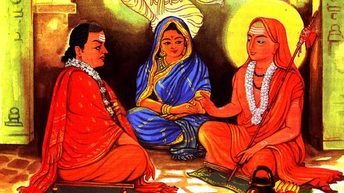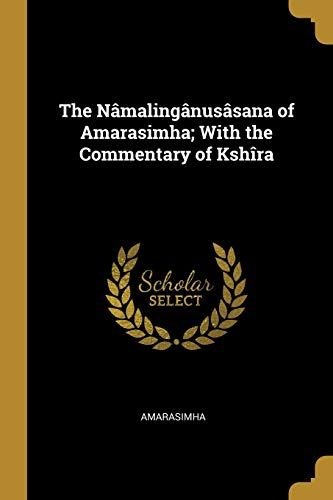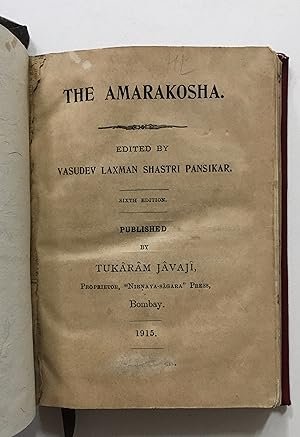Discovering the Linguistic Legacy of Amarasimha: Unveiling the Secrets of the Lexical Labyrinth

Amarasimha, born circa CE 375, stands as a notable figure in the realms of Sanskrit grammar and poetry in ancient India. Regrettably, scarce historical records provide insights into his personal life. Nevertheless, he is often referred to as one of the luminaries who embellished the court of Vikramaditya, with the contextual evidence, as documented by Xuanzang, pointing towards Chandragupta Vikramaditya, otherwise known as Chandragupta II, who reigned around CE 375. Alternative accounts ascribe his era to the reign of Vikramaditya in the 7th century. Amarasiṃha’s literary contributions have regrettably suffered a considerable loss, leaving only the renowned work, the Amara-Kosha (Amarakośa), or the Treasury of Amara, to endure the test of time. The earliest dependable reference to the Amarakosha can be traced back to the Amoghavritti by Shakatayana, a composition from the epoch of Amoghavarsha (814-867 CE). The Amarakosha, recognized as a trilateral compendium of Sanskrit vocabulary spanning three volumes, is often denoted as the Trikāṇḍī or the “Tripartite” lexicon. It is alternatively referred to as “Namalinganushasana.” Comprising an extensive lexicon of 10,000 words, the Amarakosha follows the customary practice of metrical organisation, akin to other compositions of its genre, with the purpose of facilitating memorization.

The Antecedent Years of Amarasimha
The early life of Amarasimha, a distinguished Sanskrit grammarian and poet of ancient India, is a matter of historical scarcity, and the details surrounding his formative years are relatively undocumented. Born around the approximate period of CE 375, Amarasimha emerged as a prominent figure in the domains of Sanskrit scholarship during a time of great intellectual and literary vibrancy.
Within the extant historical accounts, he is most notably recognized as one of the luminaries said to have graced the court of Vikramaditya. This designation, however, introduces a notable historical ambiguity, as it could pertain to Chandragupta Vikramaditya I, who ruled in the 4th century CE, or to subsequent rulers bearing the same title. The uncertainty surrounding Amarasimha’s exact patronage thus engenders academic debate.
Given the limited availability of concrete data pertaining to Amarasimha’s early life, scholars primarily rely on the contributions he made to the fields of Sanskrit grammar and poetry, notably exemplified by his renowned work, the Amara-Kosha. This esteemed lexicon, a testament to his erudition and linguistic mastery, continues to be a pivotal resource for students of Sanskrit.
Prominent Literary Contributions of Amarasimha
The corpus of Amarasiṃha’s literary oeuvre has suffered significant attrition over the passage of time, leaving a dearth of surviving works. Nevertheless, it is imperative to note that a noteworthy exception to this loss is the highly esteemed and enduring Amara-Kosha. The Amarakosha, often referred to as the “Treasury of Amara,” stands as a paramount lexicon within the pantheon of classical Sanskrit lexicographical works. Attributed to the celebrated ancient Indian grammarian and poet Amarasimha, this seminal text remains a cornerstone in the field of Sanskrit lexicography, providing a comprehensive and meticulously organised compilation of Sanskrit vocabulary. This academic exploration offers an in-depth analysis of the Amarakosha, elucidating its structural characteristics, lexicographical significance, and lasting influence. The Amarakosha is a three-book lexicon, epitomising the tripartite structure that distinguishes it within the domain of classical Sanskrit lexicography. Its origin is traditionally ascribed to Amarasimha, whose approximate lifespan is situated within the historical timeframe ranging from the 4th to 7th century CE. This monumental work contains an extensive repository of approximately 10,000 words, meticulously arranged and organised in metrical verses, reflecting the metrical tradition observed in classical Sanskrit literature and intended to facilitate memorization.

Amarakosha also has structural characteristics. The Amarakosha is often referred to as the Trikāṇḍī or the “Tripartite” lexicon due to its division into three distinct books. These books categorise the vocabulary into various thematic groups, thereby enabling efficient access and reference for students and scholars.The Amarakosha is uniquely organised in metrical verses. These metrical structures not only contribute to its aesthetic quality but also serve as mnemonic devices, aiding students in the memorization of the vast lexicon. The precise metrical arrangement is indicative of the meticulous scholarship and pedagogical intention behind the work.
In addition to this, Amarakosha is of lexicographical significance. Amarakosha provides an exhaustive compilation of Sanskrit words, their meanings, and appropriate usage. It plays an instrumental role in enriching and expanding the vocabulary of Sanskrit scholars and writers. The lexicon meticulously details the meanings and nuances of words, ensuring semantic accuracy and precision in the use of Sanskrit terms. Amarakosha serves as an invaluable resource for the study of classical Sanskrit literature, grammar, and linguistic analysis. It enhances the understanding of classical texts, allowing scholars to navigate the complex tapestry of Sanskrit language and culture.

The Enduring Influence and Scholarly Legacy of Amarasimha
The legacy of Amarasimha, the venerable Sanskrit grammarian, and poet from ancient India, reverberates through the annals of academic inquiry. His contributions to the realms of lexicography and linguistic scholarship continue to exert a profound influence on
contemporary Sanskrit studies. This comprehensive examination elucidates the manifold ways in which Amarasimha’s enduring legacy persists within the academic domain.
The inaugural chapter of the Kosha was typeset in Tamil script and disseminated in Rome during the year 1798. A comprehensive edition of the entire text, enriched with English annotations and an inclusive index, was made accessible to the public by Henry Thomas Colebrooke in Serampore in 1808. The Sanskrit original was subsequently printed in Calcutta in 1831. A noteworthy contribution to the field included a French translation authored by ALA Loiseleur-Deslongchamps, which was brought to print in Paris in 1839. Furthermore, B. L. Rice undertook the compilation of the text in Kannada script, juxtaposed with explanations in both English and Kannada, culminating in its publication in 1927.
Amarasimha’s most celebrated work, the Amara-Kosha, stands as a touchstone in the field of Sanskrit lexicography. Its meticulous organisation and encyclopaedic coverage of Sanskrit vocabulary have set enduring standards for lexicographical scholarship. Scholars, students, and linguists continue to rely on the Amara-Kosha as an indispensable resource for lexical research and semantic precision. Its influence extends to pedagogical materials and reference works dedicated to Sanskrit language and literature.
The Amara-Kosha’s systematic treatment of word meanings and their nuances contributes significantly to the enhancement of semantic precision in the use of Sanskrit vocabulary. Amarasimha’s work remains an authoritative source for disambiguating and clarifying the myriad meanings and contexts in which words may be employed in classical Sanskrit texts.
Amarasimha’s lexicographical and grammatical expertise serves as a vital foundation for the study of classical Indian languages and linguistics. His work continues to be instrumental in linguistic analyses, etymological inquiries, and comparative philology. It is a testament to his profound contributions to the understanding of the Sanskrit language and its historical evolution.
Beyond its linguistic import, Amarasimha’s legacy extends into the broader realm of Indian culture and literature. His work offers a window into the rich linguistic tapestry of classical Sanskrit texts, shedding light on the cultural and historical context in which they were composed. His influence echoes through the literary heritage of India, ensuring the preservation and appreciation of its linguistic heritage.
Conclusion
In conclusion, the scholarly contributions of Amarasimha, the revered Sanskrit grammarian and lexicographer, are indelibly etched into the annals of academic inquiry. His legacy, spanning several centuries, continues to exert profound influence and remains a bedrock of Sanskrit studies. Amarasimha’s magnum opus, the Amara-Kosha, a comprehensive tripartite lexicon of Sanskrit vocabulary, is a testament to his meticulous scholarship, pedagogical acumen, and enduring commitment to the preservation and propagation of the Sanskrit language and its multifaceted nuances.
Amarasimha’s influence on Sanskrit lexicography is manifest in the enduring popularity of the Amara-Kosha, a foundational resource for lexical research and semantic precision. His systematic treatment of word meanings and their nuanced interpretations has enriched the precision of Sanskrit usage, guiding scholars and linguists in their comprehension of classical texts. His work transcends the confines of linguistic scholarship, extending its reach into linguistic analyses, etymological inquiries, and comparative philology.

Moreover, Amarasimha’s legacy extends beyond the realms of linguistics to the broader cultural and literary heritage of India. His lexicon provides valuable insights into the linguistic tapestry of classical Sanskrit literature, illuminating the historical and cultural contexts in which these timeless works were composed. His enduring influence ensures the continued appreciation of India’s linguistic and literary wealth, fostering a profound connection between contemporary scholars and the literary heritage of antiquity.
The translations, annotations, and adaptations of the Amara-Kosha into various languages and scripts, as evidenced by the works of scholars like Colebrooke, Loiseleur-Deslongchamps, and B. L. Rice further attest to the enduring relevance and global reach of Amarasimha’s contributions. These efforts not only facilitate access to his seminal work but also highlight the universality of his linguistic and lexicographical insights.
In summary, Amarasimha stands as an iconic figure in the academic domain, leaving an indelible mark on the study of Sanskrit language and literature. His contributions, manifested in the Amara-Kosha and perpetuated through subsequent scholarly endeavours, continue to inspire and guide generations of linguists, scholars, and enthusiasts, ensuring that the profound linguistic and cultural heritage of ancient India remains accessible and revered.


